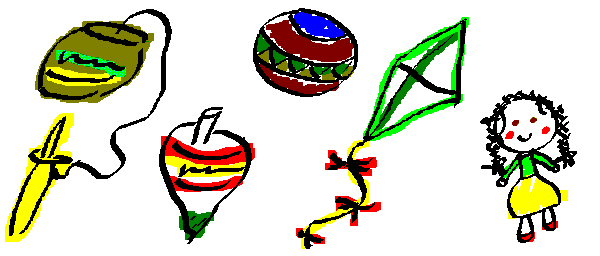
Note to English speaking visitors: I decided to finish the spanish section completely before continuing with the English version, so you will only find small parts of this site in English. I hope you don't mind this temporary inconvenience. If I receive enough requests for the English version I will finish it, so if you consider it would be useful to you, or to other English-speaking surfers, please drop me an e-mail. The document's content in english is a little different from the Spanish version. The main reason for the difference is that several toys or games have no equivalent in other countries, or have a different set of rules for play. In addition there are words that are difficult to translate, so I decided to leave them in Spanish. Anyway, I am doing my best to keep both versions as complete as possible.Nota: El contenido de los documentos en inglés es un poco diferente a la versión en español, las razó es que varios juguetes o juegos no tienen equivalente en otros países o tienen un conjunto diferente de reglas, además hay palabras que son difíciles de traducir, así que decidí dejarlas en español. De cualquier forma estoy dando mi mayor esfuerzo para mantener ambas versiones tan completas como sea posible.
The goal of this page is to give a small support to our popular traditions in order to keep them, showing a small part of the craft work which has been performed in Mexico through the centuries. Showing also that there is not much difference between the toys of mexican boys and girls and the toys used by children from other countries.
You will find images of different toys, their manufacture and their use, it is also included pharagraphs of the toys description, their technics and manufacture materials, history and different ways of use.
This work does not pretent to be a study of the mexican toys, but a summary of information and images of different sources, including books and magazines, craftsman and children of any age who use or used the toys. Of course, this includes my personal experiences with the toys, and the experiences of those who use them.
What boy haven't ever had in his hands, at least once a ball or a little car? or what girl haven't carried a doll in her arms at least for just a moment?.
Many of the Mexican traditional toys appear from the crossbreeding of the toys brought by the european and oriental people with the materials and mexican traditions.
The toy has been an essential part for the formation of the children's character. In the 60's and 70's, it was relatively common to give a football ball, a gun or a rifle to a boy, instead of giving him a puppet or marionette; however a doll, a tea or a kitchen set was given to a girl instead of giving her a football ball.
Thanks to the magic of a children's imagination, a ball in a kid's hands can become a planet, a monster, a flower or an animal. A box can become the most elegant house a doll ever had, or a load truck. The base of having fun can be any object. I still remember, when at the primary school, my classmates and I used to make a ball with a plastic bag stuffed with pieces of paper and cloth to play a soccer game.
The traditional toys are those which have been manufactured and used through generations, that have had just a few changes on the manufacture technics, as well as the materials used.
In order to give a little order on the information of this page, a classification was made, which may look a little arbitrary for some people. This classification is based on personal criteria, more than historical or functional criteria.
Because of the time the toys were used (or are used) they are divided in present and prehispanic toys. In the first group are included the toys still manufactured today, and in the second group we can find what have been considered as "games" (quite possible without being in the stict sense of the word)from the period before the spanish conquest.
Bibliography and References:
"El juguete mexicano: Un mundo de fantasía y color al alcance de todos"; México desconocido; Vol. 14, Number 169, pp. 27-30, March 1995.
"¿Cómo dice que se dice?"; México desconocido, Number 149, p. 24; Number 145, p. 29; Number 139, p. 35, sept. 1988.
"Juguetes populares para nuestros hijos"; México desconocido; Number 74, pp. 12-15, January 1983.
Sánchez Santa Ana, María Eugenia; "Muñecas Mestizas"; Instituto Nacional de Antropología e Historia; 1st. Edition: 1992, México.
Scheffler, Lilian; "Como aguinaldo de juguetería"; Procuraduría Federal del Consumidor, Fernández Cueto Editores; October 1992, México.